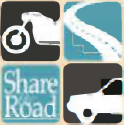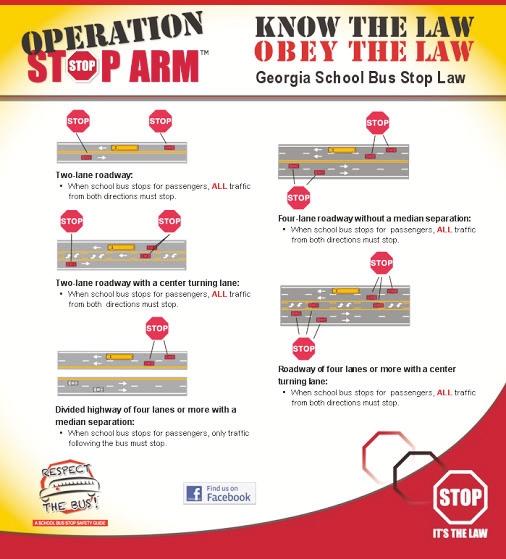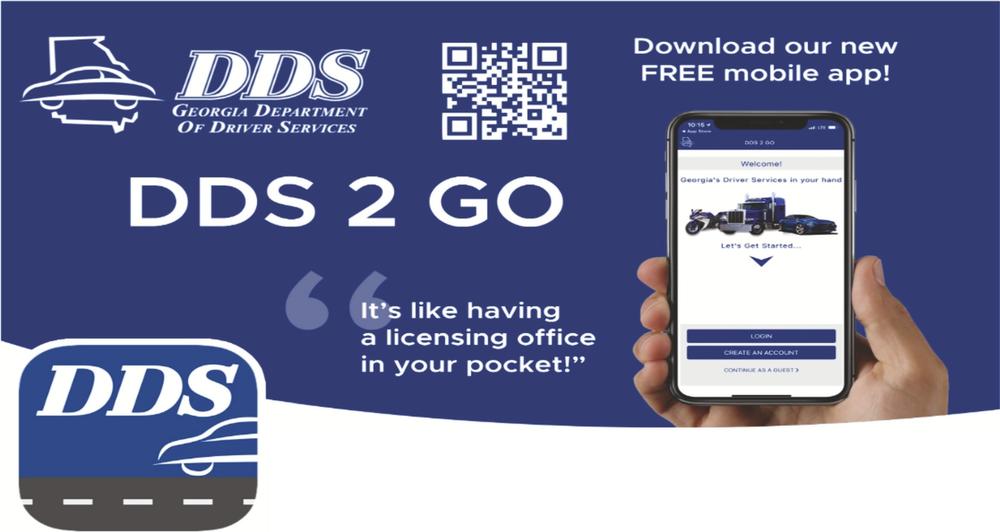
Section 9 Continued: Sharing the Road
Share the Road
This section is designed to encourage drivers of all other kinds of vehicles and motorcyclists to "share the road" with each other and is provided through the courtesy of the Motorcycle Safety Foundation and the National Highway Traffic Safety Administration.


Sharing the Road With School Buses
In most cases, all drivers are required to stop when approaching or meeting a stopped school bus that has its lights flashing and is loading or unloading passengers. The exception to this rule is when highways are separated in the center by median strips. In this situation, only vehicles following or traveling alongside a school bus in the same direction must stop.
A warning will be given in advance by the flashing red or amber lights on the front and rear of the bus. After stopping, you must remain stopped until the bus resumes motion or deactivates its warning signals AND all loading or unloading passengers have cleared the roadway.
Georgia Fines & Penalties
- Mandatory court appearance;
- Up to $1000 fine;
- Up to 6 points on driving record;
- A conviction under 21 years of age constitutes license suspension.
Operation Stop Arm

Operation Stop Arm long description
Know the Law. Obey the Law. Georgia School Bus Stop Law.
Two-lane roadway:
- When school bus stops for passengers, ALL traffic from both directions must stop.
Two-lane roadway with a center turning lane:
- When school bus stops for passengers, ALL traffic from both directions must stop.
Divided highway of four lanes or more with a median separation:
- When school bus stops for passengers, only traffic following the bus must stop.
Four-lane roadway without a median separation:
- When school bus stops for passengers, ALL traffic from both directions must stop.
Roadway of four lanes or more with a center turning lane:
- When school bus stops for passengers, ALL traffic from both directions must stop.
Respect The Bus! A school bus stop safety guide. Find us on Facebook.
Sharing the Road With Commercial Motor Vehicles
Commercial motor vehicles are vital to the economy of Georgia and the United States. Most of the products used in every day life were delivered to stores by commercial motor vehicles. Drivers of commercial motor vehicles are trained, specially licensed driving professionals.
Sharing the road with commercial motor vehicles is a necessary part of travel. Heavy trucks typically weigh 80,000 pounds or more, and drivers should use caution when driving near them.
Everyone should be aware of the differences between trucks and cars and behave accordingly. These include:
- A fully loaded tractor-trailer, traveling 55 mph, needs 3 times the distance a car needs to stop;
- Large trucks are more difficult to maneuver, are longer and heavier, and require much more room to turn;
- Large trucks have larger blind spots, called “No-Zones.”
The “No-Zone” represents the danger areas around trucks and buses where crashes are more likely to occur. Some No-Zones are actual blind spots or areas around trucks and buses where your car “disappears” from the view of the drivers. These blind spots are the Side No-Zone, Rear No-Zone, and Front No-Zone areas.
- Side No-Zones - Trucks and buses have big No-Zones (blind spots) on both sides. They are much larger than a car's blind spots. If you cannot see the driver's face in the side-view mirror, the driver cannot see you. The right side No-Zone is particularly dangerous because truck and bus drivers must make wide right turns.
- Rear No-Zones - Unlike cars, trucks and buses have huge No-Zones directly behind them. Trucks and buses have no rear view mirror. The truck or bus driver cannot see your car there and you cannot see what is going on ahead of the truck or bus. It is critical to keep a safe distance behind a truck or bus in case the driver slows or stops suddenly.
- Front No-Zones - Trucks and buses require more room and time to stop than cars. Because of this, more space should be given in front of trucks and buses. It is not safe to "cut in front" of a truck and then slow down. To avoid the Front No-Zone, make sure that you can see the entire front of the truck or bus in your rear-view mirror before you merge or pull into that lane of traffic.
The Georgia Tact Project
Targeting Aggressive Cars & Trucks
Law Enforcement officers are stopping people who drive unsafe around commercial motor vehicles, whether they are driving a car or commercial motor vehicle.
What to do to avoid getting a citation:
- Don't cut off commercial motor vehicles. For safety, one car length for every 10 miles per hour of speed is recommended;
- Don't tailgate. Unlike cars, commercial motor vehicles have big blind spots behind them. Also, car drivers who tailgate commercial motor vehicles can't see traffic ahead. If the commercial motor vehicle brakes suddenly, you have no time to react and no place to go;
- Don't speed. Speed is a factor in nearly one-third of all fatal crashes;
- Allow commercial motor vehicles plenty of room. Be careful when you or the commercial motor vehicle are entering a highway or merging with traffic.
Don't get a citation.
Tips for Trailering
For many drivers, towing a trailer is a whole new experience with many challenges — here are a few tips to stay safe on the road.
- Take Your Time
- If You Lose Control, Stay Calm
- Stay Within Capacity
- Distribute the Weight
- Inspect Your Trailer
- Know Your Trailer and Practice Handling It
- Secure Your Load
- Maintain your Trailer and Vehicle
- Consider Tow Mirrors
- Get the Right Equipment
- Consider Additional Safety Equipment
More information can be found at AAMVA.org on Safe Trailering.
DDS 2 GO

- Reinstatements
- Motor Vehicle Report
- Renewal
- Replacement
- Change of Address
- Custom Alerts
- Locations
- Pay fees
- And More!
Get the DDS 2 GO mobile app on the Apple App Store and Google Play.